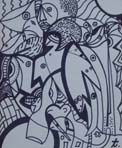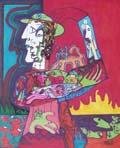



| home |
|
suganuma gallery TOMMY TRANTINO Japanese |
||||||||||||||||||
|---|---|---|---|---|---|---|---|---|---|---|---|---|---|---|---|---|---|---|---|---|
| Guide in classroomipaintingEsculptureEThe Eastern Academy) | ||||||||||||||||||||
| sojiro suganuma introduction | ||||||||||||||||||||
| suganuma gallery | ||||||||||||||||||||
| Exhibition information | ||||||||||||||||||||
| Where to make contact | ||||||||||||||||||||
| Link | ||||||||||||||||||||
| suganuma gallery |
| TOMMY TRANTINO | ||
 |
 |
 |
| No1 | No2 | No3 |
| acrylic | acrylic | pen |
| 15cmx23cm | 12.5cmx25.5cm | 18cmx21.5cm |
 |
||
| No4 | ||
| pen | ||
| 27cmx32.5cm | ||
| sold out | ||
| About TOMMY TRANTINO | |
| 1938 | Born on the Lower East Side of New York. |
| 1964 | Sentenced to death in the electric chair for killing two policemen. Spends the next 8 years in the Death House in solitary confinement, under a sentence of death. Condemned to death, Tommy is spiritually transformed and discovers his talents as a writer and as an artist. |
| 1972 | United States Supreme Court rules his death sentence unconstitutional and converts the death sentence to a life sentence. He is placed in the general prison population to serve out his time. |
| 1974 | Tommyfs autobiography gLock The Lock is published by Alfred A. Knopf. Henry Miller, Irving Stettner and many other great writers and artists praise his talents. Tommyfs close friend Irving Stettner publishes Tommyfs writings and drawings in Irvingfs highly acclaimed STROKER magazine. |
| 1989 | One-man show at Bateau-Lavoir Gallery in New York. |
| 2002 | After serving 39 consecutive years in prison, Tommy is paroled by the New Jersey Supreme Court. He currently resides in the State of New Jersey, working as the Program Coordinator for a Quaker sponsored Reentry program called FRIENDS Transition Support Services, helping prisoners released from prison to make a successful transition back into society. |
| 2007 | One-man show at Suganuma Gallery in Tokyo. |
| THE PAINTINGS OF TOMMY TRANTINO |
|
Yes, man is capable of anything; or the human spirit is, as these
paintings give us all-inspiring evidence of. It is the power of the artist
wielding the tool of self-expression, the only weapon at his command; portraiting
his inner feelings, frustrations, anguish, despair and compassion for mankind.
The necessity for expression so urgent he does it with any medium at hand,
including cheap stationery, broken eggshells, plain sugar. Is it any wonder
that Trantino should paint horripilating heads, one-eyed, ghoulish monsters
who stare numbly into space, their unique eye red-rimmed with pain? No,
as he is daily confronted with the cold, impersonal State, the same that
can pull hypocritically the starting switch of the electric chair, or the
atomic bomb. We identify with these paintings, as if gazing into a mirror because
we are all prisoners today, even those of us outside, the so called gfreeh;
all prisoners of our Time, itfs uncertainty, dead conventions, insanities,
violence, mass media, and conniving politicians. There is also a
certain joy in Trantinofs paintings. First, the joy of a man who has found
himself, since he first started to paint and write when in a solitary sell in
State Prison, on Death Row, where he stayed for eight years. And also the joy
of the creator, the man who found the miracle of beauty of his fingertips, and
found inner freedom. The man who found he could create his own world. |
| Irving Stettner, April 1989 |
|
Excerpts from the release about Trantinofs
one-man show at Bateau-Lavoir Gallery in |